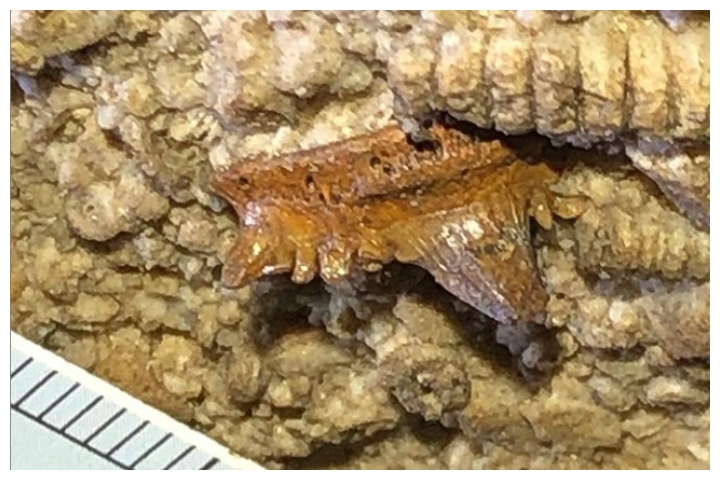The 330-million-year-old remains of a great white-sized shark have been found inside a cave in Kentucky in an exceedingly rare discovery for a creature that typically does not survive the fossilization process.

Paleontologists say they’ve found several shark fossils, including part of a large shark’s head and dorsal fins, in an underground network at Kentucky’s Mammoth Cave National Park. The shark remains were found after a lengthy mapping project in the caves last year.
“I wasn’t exactly sure what I was going to see in the cave during my trip in November,” paleontologist John-Paul Hodnett told the Courier-Journal newspaper.
“When we got to our target specimen, my mind was blown.”
Scientists Rick Olson and Rick Toomey found between 15 and 20 fossilized sharks in the cave, including the head of one embedded in a rock wall, Forbes reports. They took several photos of the shark head and sent the images to Hodnett, who has experience with sharks from the Paleozoic era.
Hodnett identified a lower jaw, skull cartilage and several teeth belonging to Saivodus striatus, a large shark that lived some 330-340 million years ago. He estimates the shark was between five and six metres long, based on a roughly 70-centimetre-long lower jaw.
https://www.instagram.com/p/B4gNrUmFmKf/?utm_source=ig_web_copy_link
The shark was found in a layer of limestone that dates back to the Late Mississippian period, when much of North America was under water.
“It’s super-exciting but not exactly the most easy thing to study,” Hodnett told CNN.
“Caves are a very special environment, so it’s not ideal to be removing big chunks of rock out of it and damage the environment by doing this.”
Shark teeth are made from bone and enamel, making them ideal for fossilization. However, most sharks’ bodies don’t survive the fossilization process because they’re made from cartilage, which is softer than bone, Hodnett explained.
Saivodus striatus is a truly ancient shark species, predating even the largest-ever shark, the megalodon, by hundreds of millions of years. The megalodon is thought to have died out some 2.6 – 3.6 million years ago, leaving its cousin, the great white, to become the ocean’s top predator.
https://www.instagram.com/p/B4d9dTZplWM/?utm_source=ig_web_copy_link
Olson and Toomey took the photos for what they’re now calling the Mammoth Cave National Park Fossil Shark Research Project. They plan to present a preliminary account of their work alongside Hodnett in October at the Society of Vertebrate Paleontology’s meeting in Cincinnati, Ohio.

The specimens in Mammoth Cave are extremely detailed and mostly intact, Hodnett said. Their teeth are embedded in the walls and ceiling of the cave, and several dorsal fins from other species are also visible.
He added that the discovery will help broaden scientists’ understanding of Paleozoic sharks, which are well-documented in Europe but not in North America.
“We’ve just scratched the surface,” Hodnett told the Courier-Journal. “But already, it’s showing that Mammoth Cave has a rich fossil shark record.”
— With files from the Associated Press




Comments